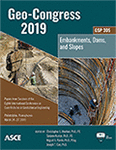Eighth International Conference on Case Histories in Geotechnical Engineering
Finite Element Modeling of Partial Penetration Well Uplift Factors
Publication: Geo-Congress 2019: Embankments, Dams, and Slopes (GSP 305)
ABSTRACT
Partially-penetrating wells have been used since the late 1700s for agricultural and construction dewatering and since the 1930s for flood protection structure seepage control. Systems design requires consideration of boundary conditions, foundation characteristics, and well losses to determine the needed number, size, spacing, and penetration of wells to achieve project objectives. Design often involves the estimation of flow to and head reduction from an infinite line of partially-penetrating artesian wells with a line source of seepage. Electrical analogy and physical models with theoretical studies led to the development of a design chart (nomogram) for this purpose by the 1950s. This nomogram has been widely employed and yields uplift factors which can be used to estimate flows and foundation head reductions for a given system geometry. While not as broadly employed for systems design, analytical solutions developed in the 1970s–1980s, and recent three-dimensional computer modeling can also be used to compute uplift factors. This paper offers a review of partial penetration artesian well systems design and provides finite element modeling-derived uplift factors. While isolated errors were identified in a few historical publications, this study further validates prior approaches, and shows that the various methods provide practically similar uplift factor solutions for well systems design.
Get full access to this article
View all available purchase options and get full access to this chapter.
REFERENCES
Barron, R. A. 1947. "Discussion of "Relief Wells for Dams and Levees". ASCE Transactions Vol. 1121372-1376.
Barron, R. A. 1948. "The Effect of a Slightly Pervious Top Blanket on the Performance of Relief Wells." Proc. 2nd Int. Conf. on Soil Mech. and Found. Eng. Netherlands. 342.
Barron, R. A. 1978-1982. "Unpublished reports concerning "Mathematical Theory of Partially Penetrating Relief Wells". (U.S. Army Engineer Waterways Experiment Station).
Bennett, P. 1946. "Effect of Blankets on Seepage through Pervious Foundations." American Society of Civil Engineers, Transactions Vol. 111215-252.
Bennett, P. T., and R. A. Barron. 1957. "Design Data for Partial. Pen. Relief Wells." Proc., 4th Int. Conf. on Soil Mech. and Found. Eng., Vol. 2, Div. 3b-6. London, UK. 282-285.
Bureau of Indian Standards. 1992. "Code of Practice for Design, Construction, and Maintenance of Relief Wells." New Delhi.
Darcy, H. 1856. Les Fontaines Publiques De La Ville De Dijon. Paris, France.
Guy, E. D., R. L. Nettles, J. Davis, S. Carter, and L. Newberry. 2010. "Relief Well System Design Approach: HHD Case Study." Assoc. State Dam Safety Officials Proc. Charleston, WV.
Johnstone, J. 1797. An Account of the Most Approved Mode of Draining Land, According to the System Practised by Mr. Joseph Elkington. London.
Leonards, G. 1962. Foundation Engineering.McGraw-Hill.
Middlebrooks, T. A., and W. H. Jervis. 1947. "Relief Wells for Dams and Levees." ASCE Transactions Vol. 1121321-1338.
Muskat, M. 1937. The Flow of Homogeneous Fluids through Porous Media. New York, NY: McGraw-Hill Book Company, Inc.
Ohm, G. S. 1827. Die Galvanische Kette Mathematisch Bearbeitet. Berlin, Germany.
Rocscience, Inc. 2018. Rocscience RS3. https://www.rocscience.com/software/rs3.
Sharma, S. N. P. 1974. "Partially Penetrating Multiple-Well System in a Confined Aquifer with Application to Relief Well Design." Journal of Hydrology, 231-37.
Terzaghi, C. 1927. "Wellpoint Method for Handling Excavation of Foundation Pit at New Sewage Pumping Station" J. of the Boston Soc. of Civil Eng. XIV (7): 63-71.
Turnbull, W. J., and C. I. Mansur. 1959. "Construction and Maintenance of Underseepage Control Measures." J. Soil Mech. and Found. Div., Proc. ASCE97-124.
USACE. 1939. "Miss. River Levees Underseep. Studies - Black Bayou Levee." Vicksburg, MS.
USACE. 1944. "Design of Relief Well Systems." Conference on Control of Underseepage. Cincinnati, OH. 81-103.
USACE. 1941. "Investigation of Underseepage, Lower Mississippi River Levees, Tech. Memo. No. 184-1." Vicksburg, MS.
USACE. 1949. "Relief Well Systems for Dams and Levees on Pervious Foundations." Waterways Experiment Station Technical Memorandum No. 3-304, Vicksburg, MS.
USACE. 1952. "Seepage Analysis and Control for Dams." EM 1110-2-1901, Washington, DC.
USACE. 1955. "Relief Well Design." Civil Works Engineer Bulletin 55-11, Washington, DC.
USACE. 1956. "Investigation of Underseepage and Its Control, Lower Mississippi River Levees, Vol. 1." Vicksburg, MS.
USACE. 1992. "Design, Construction, and Maintenance of Relief Wells." Engineer Manual (EM) 1110-2-1914, Washington, DC.
Yanai, K. 1963. "Fund. Probl. Rel. Relief Well, Soils & Found." Jap. Geot. Soc. 3 (2): 49-62.
Information & Authors
Information
Published In
Geo-Congress 2019: Embankments, Dams, and Slopes (GSP 305)
Pages: 57 - 66
Editors: Christopher L. Meehan, Ph.D., University of Delaware, Sanjeev Kumar, Ph.D., Southern Illinois University Carbondale, Miguel A. Pando, Ph.D., University of North Carolina Charlotte, and Joseph T. Coe, Ph.D., Temple University
ISBN (Online): 978-0-7844-8207-0
Copyright
© 2019 American Society of Civil Engineers.
History
Published online: Mar 21, 2019
ASCE Technical Topics:
- Computer models
- Engineering fundamentals
- Finite element method
- Foundation design
- Foundations
- Geomechanics
- Geotechnical engineering
- Groundwater
- Methodology (by type)
- Models (by type)
- Numerical methods
- Seepage
- Soil dynamics
- Soil mechanics
- Soil properties
- Structural models
- Three-dimensional models
- Uplifting behavior
- Water (by type)
- Water and water resources
- Water management
- Wells (water)
Authors
Metrics & Citations
Metrics
Citations
Download citation
If you have the appropriate software installed, you can download article citation data to the citation manager of your choice. Simply select your manager software from the list below and click Download.
